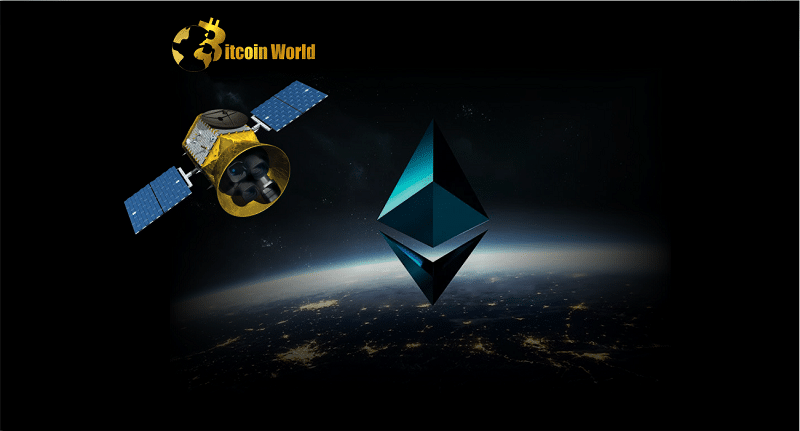In the ever-evolving world of blockchain, security and scalability are paramount. Ethereum, a leading force in this revolution, is constantly seeking innovative ways to enhance its infrastructure. Enter the KZG ceremony, a crucial process aimed at strengthening Ethereum’s scaling capabilities. And now, in a groundbreaking move, this ceremony is getting an extraordinary assist – from space!
What’s the Buzz About the KZG Ceremony and Why Does it Need Space?
You might be wondering, what exactly is this KZG ceremony, and why is space even involved? Let’s break it down:
- Ethereum Scaling: Ethereum is working towards upgrades that will significantly improve its transaction speed and efficiency – a concept known as ‘scaling’. The KZG ceremony is a vital cryptographic step in this direction.
- Cryptography is Key: This ceremony requires generating special ‘cryptographic parameters’ – think of them as secret ingredients that underpin the security of the new Ethereum infrastructure.
- The Randomness Factor: To ensure these parameters are truly secure and tamper-proof, they need to be generated using a source of genuine randomness. This is where things get interesting.
Traditionally, generating strong randomness can be challenging. Enter Cryptosat, a company leveraging the unique environment of space to provide an unparalleled source of entropy.

Cryptosat: Bringing Cosmic Randomness to Ethereum’s Doorstep
On April 4th, 2024, Cryptosat made headlines by contributing entropy to the Ethereum KZG ceremony directly from space. Their Crypto2 satellite, orbiting 550 kilometers above Earth, became a participant in securing the future of Ethereum. Here’s why this is a big deal:
- Orbital Advantage: Cryptosat’s satellite orbits Earth every 90 minutes, far from easy access. This physical isolation is crucial for generating secure cryptographic parameters.
- Verifiable Random Beacon: Cryptosat provides a ‘Verifiable Random Beacon’ service. This means they generate entropy in space, sign it cryptographically with the satellite’s private key (generated in space too!), and make it verifiable using a public key.
- Transparency in Space: You can even track Cryptosat’s contribution in real-time! A public dashboard shows the satellite’s trajectory and status, adding a layer of transparency to this unique process.
The Shadow of ‘Toxic Waste’: Why Space Offers a Secure Solution
Yan Michalevsky, co-founder of Cryptosat, highlights a critical security concern: ‘toxic waste’. This term refers to intermediate computational byproducts generated during the cryptographic parameter creation process. If this ‘toxic waste’ is leaked, it could compromise the entire cryptographic scheme upon which the upgraded Ethereum will be built.
Think of it like this: you’re making a super-secure vault, and during the process, you generate some temporary keys. If these temporary keys fall into the wrong hands, the vault’s security is at risk, even if the final vault itself is strong.
Why Space is the Ideal Secure Environment:
- Physical Isolation: As Michalevsky explains, space provides “a completely physically isolated environment from which no data can be extracted.” It’s incredibly difficult for malicious actors to intercept or tamper with data generated in orbit.
- Reduced Risk of Leakage: Generating cryptographic parameters in space significantly minimizes the risk of ‘toxic waste’ leakage, bolstering the integrity of Ethereum’s security framework.
Beyond Security: What Does This Mean for Ethereum and the Future?
Cryptosat’s contribution is more than just a technical feat; it’s a significant step towards:
- Enhanced Security for Ethereum: By leveraging space-based randomness, Ethereum’s KZG ceremony becomes even more robust and resistant to potential attacks.
- Innovation in Cryptography: This demonstrates the potential of using space technology to solve real-world cryptographic challenges.
- Decentralization and Trust: The participation of thousands of individuals and organizations, including Cryptosat, in the KZG ceremony reinforces the decentralized and community-driven nature of Ethereum.
- Preparing for the Shanghai Upgrade: The entropy generated by Crypto2 is directly relevant to the upcoming Ethereum Shanghai mainnet upgrade, scheduled for April 12th, highlighting the timely and crucial nature of this contribution.
Space: The New Frontier for Bulletproof Cryptography?
Cryptosat’s vision extends beyond just this single contribution. They believe that space is becoming a crucial “battleground in the quest for bulletproof cryptography.” With satellites like Crypto2 boasting 30 times the computing power of its predecessor, the potential for space-based cryptographic solutions is rapidly expanding.
This initiative highlights a fascinating intersection of blockchain technology and space exploration. As we move towards a more interconnected and digitally-driven future, securing our cryptographic foundations is more critical than ever. And sometimes, the best solutions might just be found by looking up – to the vast expanse of space.
The Ethereum KZG ceremony, fortified by cosmic randomness, is a testament to the innovative and collaborative spirit driving the blockchain revolution. It’s a powerful reminder that even the sky isn’t the limit when it comes to securing the future of decentralized technologies.
Disclaimer: The information provided is not trading advice, Bitcoinworld.co.in holds no liability for any investments made based on the information provided on this page. We strongly recommend independent research and/or consultation with a qualified professional before making any investment decisions.


